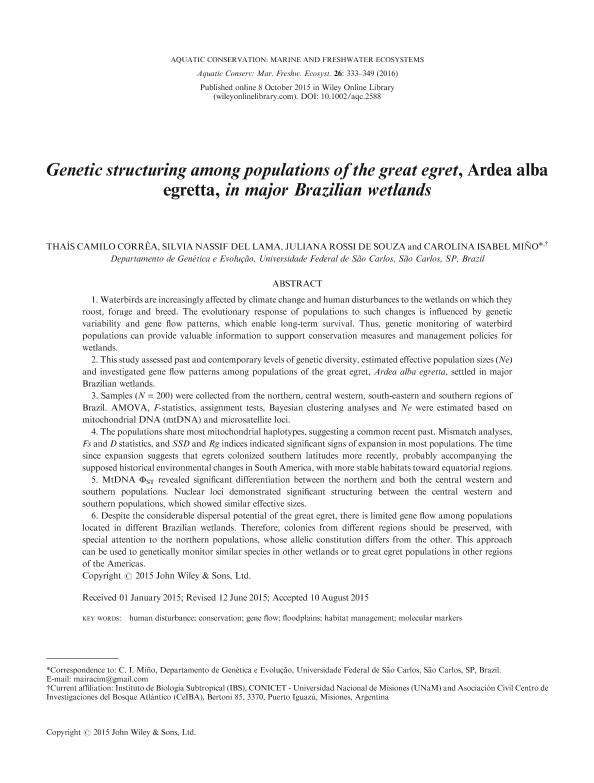Artículo
Genetic structuring among populations of the great egret, Ardea alba egretta, in major Brazilian wetlands
Fecha de publicación:
04/2016
Editorial:
John Wiley & Sons Ltd
Revista:
Aquatic Conservation: Marine and Freshwater Ecosystems
ISSN:
1052-7613
Idioma:
Inglés
Tipo de recurso:
Artículo publicado
Clasificación temática:
Resumen
Waterbirds are increasingly affected by climate change and human disturbances to the wetlands on which they roost, forage and breed. The evolutionary response of populations to such changes is influenced by genetic variability and gene flow patterns, which enable long-term survival. Thus, genetic monitoring of waterbird populations can provide valuable information to support conservation measures and management policies for wetlands. This study assessed past and contemporary levels of genetic diversity, estimated effective population sizes (Ne) and investigated gene flow patterns among populations of the great egret, Ardea alba egretta, settled in major Brazilian wetlands. Samples (N = 200) were collected from the northern, central western, south-eastern and southern regions of Brazil. AMOVA, F-statistics, assignment tests, Bayesian clustering analyses and Ne were estimated based on mitochondrial DNA (mtDNA) and microsatellite loci. The populations share most mitochondrial haplotypes, suggesting a common recent past. Mismatch analyses, Fs and D statistics, and SSD and Rg indices indicated significant signs of expansion in most populations. The time since expansion suggests that egrets colonized southern latitudes more recently, probably accompanying the supposed historical environmental changes in South America, with more stable habitats toward equatorial regions. MtDNA F(cyrillic)ST revealed significant differentiation between the northern and both the central western and southern populations. Nuclear loci demonstrated significant structuring between the central western and southern populations, which showed similar effective sizes. Despite the considerable dispersal potential of the great egret, there is limited gene flow among populations located in different Brazilian wetlands. Therefore, colonies from different regions should be preserved, with special attention to the northern populations, whose allelic constitution differs from the other. This approach can be used to genetically monitor similar species in other wetlands or to great egret populations in other regions of the Americas.
Archivos asociados
Licencia
Identificadores
Colecciones
Articulos(CCT - NORDESTE)
Articulos de CTRO.CIENTIFICO TECNOL.CONICET - NORDESTE
Articulos de CTRO.CIENTIFICO TECNOL.CONICET - NORDESTE
Articulos(IBS)
Articulos de INSTITUTO DE BIOLOGIA SUBTROPICAL
Articulos de INSTITUTO DE BIOLOGIA SUBTROPICAL
Citación
Corrêa, Thais Camilo; Del Lama, Silvia Nassif; de Souza, Juliana Rossi; Miño, Carolina Isabel; Genetic structuring among populations of the great egret, Ardea alba egretta, in major Brazilian wetlands; John Wiley & Sons Ltd; Aquatic Conservation: Marine and Freshwater Ecosystems; 26; 2; 4-2016; 333-349
Compartir
Altmétricas




